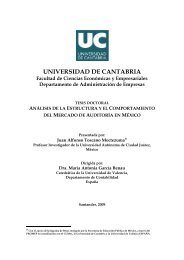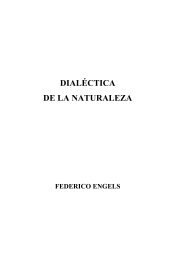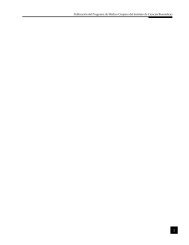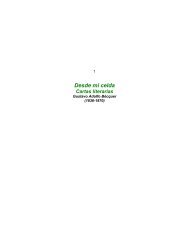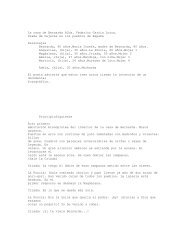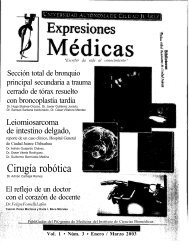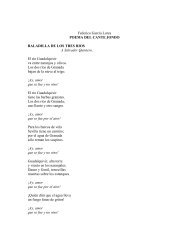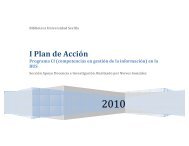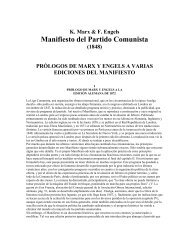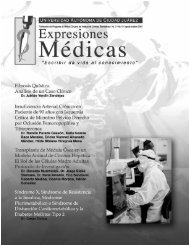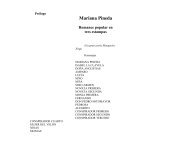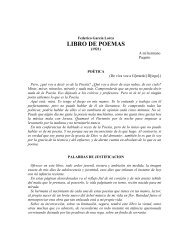Queer theory: under construction
Queer theory: under construction
Queer theory: under construction
You also want an ePaper? Increase the reach of your titles
YUMPU automatically turns print PDFs into web optimized ePapers that Google loves.
QUALITATIVE STUDIES IN EDUCATION, 1999, VOL. 12, NO. 5, 457-472<br />
<strong>Queer</strong> <strong>theory</strong>: <strong>under</strong> <strong>construction</strong><br />
PATRICK DILLEY<br />
University of California at Irvine, CA 92697-5500, USA<br />
This article outlines how the concepts of queer and queer <strong>theory</strong> have been applied to qualitative<br />
studies. The multiple definitions of queerare examined, to foster an <strong>under</strong>standing^'the positions<br />
from which theorists have utilized the concept to examine a number of disciplines. The<br />
advan cement of the tenets of queer <strong>theory</strong> is outlined chronologically, to display the evolution of the<br />
<strong>theory</strong> through intradisciplinary applications. The body of qualitative works utilizing queer<br />
<strong>theory</strong> is categorized (language, literature, and arts; history; life histories/life stories; and queer<br />
<strong>theory</strong> as praxis) and juxtaposed. In addition, efforts to define and enact a " queer pedagogy " are<br />
analyzed. Suggestions for further application of queer <strong>theory</strong> in education, ethnography, and<br />
qualitative studies conclude the article.<br />
I anticipate that out of the many questions a reader of this issue might have, the three<br />
most common are : What is queer <strong>theory</strong>? For that matter, what's queer? And do I have ( ,<br />
to be queer to practice queer <strong>theory</strong>? In this essay, I attempt to answer those questions,<br />
although I am certain the answers will be neither as definite as some might want, nor as<br />
simple or clear as I wish they would be. The state of queer and queer <strong>theory</strong>, ever the postpostmodern<br />
concepts, is as elusive to nail down as mercury. Like that element, we can<br />
contain queer <strong>theory</strong>, and it will fill - even overflow — our container; we can use it as a<br />
gauge (or guide) to the climate of lives and experiences.<br />
I offer this article as a thermometer for the body of queer research, a road map for<br />
the new queer state. To begin, I briefly review definitions and uses of the concept of<br />
queer, and follow that with a lengthier review of what queer <strong>theory</strong> is, is not, and still<br />
might be. Next, I outline queer <strong>theory</strong> as it has been utilized in qualitative research.<br />
Most of this research has been outside the domains of education, in the humanities,<br />
although several of the philosophical works might make it into an odd education course<br />
or two. In that section, I also briefly examine queer <strong>theory</strong> as praxis, and note its<br />
connectionsto other emancipatory and liberationist theories. I then conclude with ideas<br />
for future applications of queer <strong>theory</strong> and research.<br />
What is queer ?<br />
The flexibility of the English language, compounded by academics' transformation of<br />
general words into jargon, necessitates a few definitions. <strong>Queer</strong> can be an adjective, a<br />
noun, or a verb. In general use, it is most commonly an adjective, meaning "not^<br />
normal," or, more specifically, not heterosexual. The word has a negative connotation,<br />
particularly in school settings (D'Augelli, 1989a, 1989b; D'Augelli and Rose, 1990;<br />
Herdt and Boxer, 1993; Rhoads, 1994; Chandler, 1995; Due, 1995; O'Connor, 1995).<br />
<strong>Queer</strong>, as operationally defined by Doty (1993), "is a quality related to any expression<br />
that can be marked as contra-, non-, or anti-straight" (p. xv), which serves not to<br />
identify people as much as forms of communication, and the positions that inform that<br />
expression. Within the past decade, however, the adjective has been used in increasing<br />
frequency as a substitute for gay and lesbian, and to include others whose sexuality and/or<br />
Inlmmliimtl Jottnuit of Qualitative Stwlies in Education ISSN 01)51-8398 nrint/lSSN 1300-5898 online © H)!)9 Taylor & Francis Lid<br />
hun://www.lnn
458 PATRICK DILLEY<br />
gender places them outside of society's idea of "normal:" bisexuals and transgendered<br />
people (Warner, 1993; Rhoads, 1994; Perm, 1995).<br />
But queer has developed a meaning beyond its use as inclusive categorization; as a<br />
noun, the word can be used to refer to one included in the marginalized group : a queer! t<br />
Often there is a political ideology or intent when this word is used, based in part on a<br />
decision to confront what is experienced as discrimination and to commit to a collective<br />
identity based on being marginalized because of one's sexuality, rather than simply<br />
identification because of one's gender and the object of one's affection (Rhoads, 1994,<br />
1997; Jogose, 1996). In a sense, such a definition of queer is not about a lack of<br />
something (a lack of heterosexuality) (Hocquenghem, 1978), but a presence of<br />
something: a desire for same-sex experiences, a position outside of the normal trope of<br />
daily life that affords perspectives apart from the norm. It is a term that by its very use<br />
questions "conventional <strong>under</strong>standings of sexual identity by deconstructing the<br />
categories, oppositions and equations that sustain them" (Jagose, 1996, p. 97). As<br />
Honeychurch (1996) summarizes, "It is perhaps in the more expansive term 'queer'<br />
that the most possibilities emerge for denominating and declaring a range of differences<br />
and positions arising from the gamut of sexual diversities" (p. 341).<br />
Ettinger (1992) views these transformations as "discursive strategies that reject and<br />
transform the categories produced by a hostile and hegemonic heterosexual discourse"<br />
(p. 53). Indeed, Abelove's (1995) descriptions of his queer students show the effects,<br />
intentional or not, of postmodern reflection upon positionality and the power of naming<br />
by many of today's non-heterosexual students:' [QJueer students think that there is not<br />
and cannot be such a thing as authenticity, and that there certainly is not and cannot<br />
be such a thing as an "authentic lesbian sexuality"' (Abelove, 1995, p. 52).<br />
Furthermore, over the past two decades students not identifying as straight have<br />
experienced lives that differ in varying degrees from those of their predecessors, and the<br />
result is that while not being straight might not be a terrific experience for many of them,<br />
such lives and experiences are no longer considered entirely abnormal, or without<br />
precedence. Whether the result of better research and writing about growing up nonheterosexual<br />
or a solipsism of Generation X, today's non-heterosexual students have<br />
found the transformation of queer from adjective to noun empowering (Escoffier and<br />
Berube, 1991),<br />
[<strong>Queer</strong> <strong>under</strong>grads] do not typically experience their own subjectivity as<br />
marginal, even at those moments when they feel most oppressed by homophobic<br />
and heterosexist discourses and institutions. Marginalization isn't their preferred<br />
trope. It doesn't seem to them to be cogent as a narrative device for organizing the<br />
telling of their own lives, or, for that matter, of their history. What these queers<br />
prefer to say and believe or try to believe instead is that they are both present and<br />
at the center. (Abelove, 1995, p. 48) .<br />
Such a transition from the margins of concept and study to the center creates a queered<br />
position for reflection, expression, and action. From that position, analysts change queer<br />
into a verb. In academic circles, to queer something is to analyze a situation or a text<br />
to determine the relationship between sexuality, power, gender, and conceptions of<br />
normal and deviant, insider and outsider. As Honeychurch (1996) observes:<br />
A queered position requires an ontological shift comprehensively resistant in its<br />
exceptions to dominant normativity. A queering of standpoint in social research<br />
is a vigorous challenge to that which has constrained what may be known, who<br />
may be the knower, and how knowledge has come to be generated and circulated,
QUEER THEORY: UNDER CONSTRUCTION 459<br />
... [and] queers participate in positioning themselves through both authoring and<br />
authorizing experience, (p. 342)<br />
These analysts in queered positions developed queer <strong>theory</strong>.
460 PATRICK DILLEY<br />
queer <strong>theory</strong> is a logical extension of ontological philosophy. If modernism and<br />
empiricism are about objectively researching and reporting what we see/know, and<br />
postmodernism and constructivism are about investigating and reporting how the<br />
positions between researcher, researched, and research construct what we see/know,<br />
queer <strong>theory</strong> is about how both the knowledge (found and produced) and the positions<br />
(also both found and produced) create a new body of knowledge, a delimitation of the<br />
space between position and product, investigator and investigation. <strong>Queer</strong> <strong>theory</strong><br />
inverts the notion of outsider giving voice to the insider as well as the notion of insider<br />
information being untouched by outsider information.<br />
Postmodern <strong>construction</strong>ism serves as the obvious structural framework of queer<br />
<strong>theory</strong>. As the queer <strong>under</strong>grads in Abelove's courses demonstrate, sexuality is<br />
important, and serves as a focal point; while it is not the only dimension of human<br />
experience that define queers, sexuality does inform all others.<br />
Sexual orientations are not a private matter that impacts only personal sexual<br />
practices, but are dimensions of subjectivity that infuse all human experience,<br />
including higher cognitive functions; are imbricated in that sexuality, gender,<br />
class, etc.; are layered and interimplicated and therefore cannot be read<br />
monolithically; and are viewed as identities coherent enough to be recognized,<br />
but fluid enough to be interrogated. (Honeychurch, 1996, p. 345)<br />
Not every study of gay lives is queer, or benefits from queer <strong>theory</strong>. Indeed, in many<br />
ways, queer <strong>theory</strong> contradicts traditional studies that do not question the very<br />
framework of the investigation. The shift in viewpoint necessitates a shift in sensibility,,<br />
style, tone, values, and commitments. Britzman (1997) argues against examination of<br />
gay lives as overly simplistic; the questions should regard why, how, and who<br />
determines that those lives are queer: "The study of why gay rights are so difficult to<br />
achieve requires not a look into the lives of gays and lesbians but into the questions and |<br />
conditionsof why sexuality must be regulated, outlawed, and fought for" (1997, p. 36).<br />
Duggan posits that queer theorists critique three elements of research and representation:<br />
(a) humanist progressive narratives of gay identities and gay liberation<br />
against repressive forces; (b) empiricist methods claiming to present "reality" through<br />
simple and objective events, dates, and motives; and (c) "stable, unitary, or 'authentic'<br />
identity categories" (Duggan, 1995a, p. 181). Indeed, Seidman believes:<br />
<strong>Queer</strong> <strong>theory</strong> is less a matter of explaining the repression or expression of a<br />
homosexual minority than an analysis of the hetero/hompsexual figure as a<br />
power/know ledge regime that shapes the ordering of desires, behaviors, and social<br />
institutions, and social relations- in a word, the constitution of the self and societ.<br />
(Seidman, 1995, p. 128)<br />
<strong>Queer</strong> <strong>theory</strong> is not easily <strong>under</strong>stood partly because it challenges basic tropes used to<br />
organize our society and our language: even words are gendered, and through that<br />
gendering an elliptical view of the hierarchy of society, and presumption of what is male<br />
and what is female, shines through. <strong>Queer</strong> <strong>theory</strong> rejects such binary distinctions as<br />
arbitrarily determined and denned by those with social power. As Edelman's earlier<br />
quote hints, if all of these concepts are constructed out of whole cloth, it becomes difficult<br />
to explain what queer is if it is not in opposition to straight - or even to gay. Duggan<br />
(1995b) relates a funny story of a fact-checker for Rolling Stone trying to ascertain from<br />
literary critic and queer theorist Eve Sedgwick whether Sedgwick is straight or gay. The<br />
fact-checker dogs Sedgwick with questions schas, "Are you straight? If you're not
QUEER THEORY : UNDER CONSTRUCTION 461<br />
straight, you must be gay? But if you're married, you're straight, right?" Sedgwick<br />
sidesteps answering through a series of Socratic responses: "Did I say I was straight?<br />
Did I say I was gay? Did I say I was married? In some ways, I might be considered<br />
queer."<br />
The fact-checker's questions were based in the essentialist language of facts, of<br />
course, while Sedgwick was responding from a very consciously constructed position. If<br />
queer is so troublesome to use as a word that means something personally and can be<br />
easily <strong>under</strong>stood by the public, it is even more difficult to explain in plain language<br />
what queer <strong>theory</strong> is. This problem is but one example "to illustrate the difficulty of<br />
communication across the gap between the predominantly <strong>construction</strong>ist language of<br />
queer studies and the essentialist presumptions of public discourse" (Duggan, 1995b, p.<br />
183).<br />
<strong>Queer</strong> <strong>theory</strong>, then, comes from queered perspectives of the researcher and the<br />
researched. The sexual dimensions of a subject become the central site of investigation,<br />
primarily in juxtaposing the queer to the norm. This positioning represents a change<br />
both in the interests of researchers and theorists, and in those about whose lives we<br />
report. In Abelove's estimation, queer students desire a shift in the lens of study of nonheterosexual<br />
lives:<br />
[F]ocus not on the margins, but on what was "queer" in the center, such as<br />
musicals, or comedies, or films by or with homosexual (or bisexual) creators.<br />
"What could be queerer? ... All these cultural productions were central rather<br />
than marginal. By ignoring or neglecting them, we misconceive the past and<br />
unwittingly reduce our presence in and claim to the present," they say. (Abelove,<br />
1995, p. 49)<br />
Such actions and ideas go against much of what is thought, and believed, in both the<br />
academic and the lay worlds- and in doing so call into question the very concepts of<br />
those thoughts and beliefs (Penn, 1995; Seidman, 1995; Honeychurch, 1996). Who is<br />
making the claim/determination of what is normal and what is queer? What are his<br />
agendas? What are her politics? The text (broadly defined, in social sciences, as<br />
analyses, theories, identities, and discourses) is our source of knowledge but, like that<br />
text, knowledge is constructed by constructed people. In questioning such conventional<br />
wisdom both gay and straight, queer <strong>theory</strong> is all the queerer for its subjects and its<br />
subjectivities. As Britzman states:<br />
<strong>Queer</strong> Theory signifies improper subjects and improper theories, even as it<br />
questions the very grounds of identity and <strong>theory</strong>. <strong>Queer</strong> Theory occupies a<br />
difficult space between the signifier and the signified, where something queer<br />
happens to the signified- to history and to bodies- and something queer happens<br />
to the signifier-to language and to representation. (1995, p. 153)<br />
In many respects, queer <strong>theory</strong> might offer the most qualitative of methodologies for '<br />
collecting and analyzing data. As it questions, even defies, notionsof objectivity and the<br />
essentiality of fact, queer <strong>theory</strong> opens more "texts" for study, and more bodies of<br />
knowledge to compile, compare, and evaluate. " [I]t mobilizesa radically wide range of<br />
knowledge - modes of <strong>under</strong>standing from science to gossip - to reconstitute information<br />
about queerness, thus transforming the range of reference 'queer' has by<br />
multiplying its specifications" (Berlant and Freedman, 1992, p. 153). Again, the<br />
flexibility overflows the delimitations of words to contain what queer <strong>theory</strong> could be.<br />
<strong>Queer</strong> <strong>theory</strong> is not simply about the studying of people whose sex lives are not
462 PATRICK DILLEY<br />
heterosexual, or even the positionalities of those people; at its core, it is about<br />
questioning the presumptions, values, and viewpoints from those positions (marginal<br />
and central), especially those that normally go unquestioned. <strong>Queer</strong> <strong>theory</strong> is in part<br />
about opening and reclaiming spaces, both public and private (Berlant and Freeman,<br />
1992; cf. Chauncey, 1994; Bredbeck, 1995; Edelman, 1995). It "offers methods of<br />
critiques to mark the repetitions of normalcy as a structure and as a pedagogy "<br />
(Britzman, 1995, p. 153). It is the process, rather than the product, in part because the<br />
product of queer <strong>theory</strong> is often more inquiry rather than declaration.<br />
As the next section highlights, queer <strong>theory</strong> offers multiple processes, <strong>construction</strong>s,<br />
identities, and methods of deconstructing what is presented as "reality," as "normal. "<br />
These do more than explain or describe the "other," and by applying them to the<br />
"non-other," we can also help to explain and describe how, why, where, and who is<br />
"normal" or "real."<br />
<strong>Queer</strong> <strong>theory</strong> in qualitative research<br />
Just as queered positions produce queer <strong>theory</strong>, that <strong>theory</strong> of necessity creates new, or<br />
altered, methods of investigation and analysis. <strong>Queer</strong> <strong>theory</strong> has three methods of<br />
application, according to Britzman (1995, p. 155) : studying limits, studying incongruence,<br />
and studying reading practices. Britzman does not define how to use those<br />
applications, however, as the flexibility of the <strong>theory</strong> and the product require equally<br />
malleable approaches. But the manners of queer research and the resulting projects can<br />
be used to describe, and classify, queer qualitative research.<br />
Those applications have produced a variety of products in a number of academic<br />
areas. Attempting to classify a <strong>theory</strong> that posits a breakdown of classification is<br />
perilous; but while the <strong>theory</strong> is not necessarily bound by disciplines, queer <strong>theory</strong> is<br />
applied very differently within certain categories. Those categories are disciplinary, for<br />
the character of the <strong>theory</strong> - and the use of it- is distinctly different in each discipline.<br />
While one can broadly make observations about it, to explain queer <strong>theory</strong> more fully<br />
one must find connections between how writers have written about it, researchers<br />
utilized it, and theorists imagined it. For better or worse, while researchers utilize work<br />
from other fields, few stray far from their own windows in the Ivory Tower.<br />
In this respect, queer <strong>theory</strong> is more transdisciplinary rather than interdisciplinary: the<br />
concepts and the techniques can be, and are, utilized by a number of researchers in<br />
various disciplines, but the particular product or analysis in one discipline might not<br />
have any impact or influence upon another discipline. In other words, while the results<br />
of, say, a queered investigation of film studies might not interest or be applicable for<br />
educational research, the methodologies of investigation, analysis, and representation<br />
might be very relevant and provocative. And, as Britzman implies, analytical reading<br />
in areas in which one does not normally read - a reading practice- can in itself be a<br />
queer method.<br />
In reviewing published studies that utilize queer <strong>theory</strong>, I have found three tenets to<br />
queer research, regardless of discipline:<br />
• examination of lives and experiences of those considered non-heterosexual;<br />
• juxtaposition of those lives/experiences with lives/experiences considered<br />
"normal";<br />
• examination of how/why those lives and experiences are considered outside of<br />
the norm.
QUEER THEORY : UNDER CONSTRUCTION 463<br />
Not all queer research considers equally each tenet, but at minimum at least one is<br />
emphasized. In addition, researchers using queer <strong>theory</strong> also often try to find novel,<br />
creative ways of representing in print data that aid in fulfilling those tenets, In doing so,<br />
the texts become queer as well.<br />
I stated that queer <strong>theory</strong> is transdisciplinary; the body of literature of queer <strong>theory</strong><br />
reflects this, showing connections between disciplines, and advancement of the <strong>theory</strong>'s<br />
development across the disciplines, while the works produced remain tied to particular<br />
disciplines. Consequently, I broadly categorize queer research into four categories: (i)<br />
language, literature, and the arts; (ii) historiography; (iii) queer life histories/stories;<br />
and (iv) queer praxis. I briefly highlight each in this section. I do not choose the<br />
classifications based on the writers' disciplines, but rather on how they outline, develop,<br />
and suggest applicationsfor queer <strong>theory</strong>. Articles about and using queer <strong>theory</strong> appear<br />
in journals each month; new publications arrive in bookstores and libraries at an<br />
equally rapid rate, displaying the interest in - and the use of- this way of <strong>under</strong>standing<br />
and depicting the world in which we live. Consequently, as it is impossible to include<br />
every work dealing with queer <strong>theory</strong>, I present texts representative of the state of queer<br />
<strong>theory</strong> within each category, rather than attempt a comprehensive bibliography.<br />
Interestingly, much of the insight into queer lives- and the examples of how queer<br />
<strong>theory</strong> affects lives - comes not from academic theorists or researchers but from<br />
journalists, historians, literary critics, and social commentators. Accordingly, I have<br />
included in this review important, and representative, works from outside the fields of<br />
education and qualitative research. The sequence of the four categories is roughly<br />
chronological, tracing the development of queer <strong>theory</strong> across disciplines.<br />
Language, literature and arts<br />
Although there is some discrepancy as to where the term "queer <strong>theory</strong>" was first<br />
coined, as a practice it began as a tool used to examine the arts (Jagose, 1996). Sedgwick<br />
(1985, 1990, 1993), Doty (1993), Lucas (1994), Hennessy (1995), van Leer (1995), and<br />
M cRuer (1997) provide unique examinations of popular and academic texts, utilizing<br />
queer <strong>theory</strong> to decenter the norm to the margins, and shifting attention to how the<br />
writers and readers of culture and cultural products create and find meaning in books,<br />
films, television programs, music, theater, and advertising. Leap (1993/1994, 1996)<br />
delves deeply into textual analysis of how gay men communicate with each other- in<br />
comparison with how they speak with heterosexual people - and postulates a<br />
production and conveyance of culture as well as language. Much of his analysis is based<br />
on the notion that those on the margins of the normative culture learn from and<br />
communicate with others through employing a coded language that would have<br />
different meanings to someone on the fringes than to someone in the middle.<br />
Historiography<br />
If the study of literature and film was the flashpoint where queer <strong>theory</strong> took flight,<br />
history is surely the discipline which has applied the <strong>theory</strong> to produce works that both<br />
the general public and the academy use. As Abelove (1995) points out, "this change has<br />
apparently produced a partly new way of reading and thinking history" (p. 44).<br />
Duggan (1992, 1995a, 1995b) hasbeenoneoftheproponentsfor a queer historiography,
464 PATRICK DILLEY<br />
trying to energize practice through queer <strong>theory</strong>. And the histories that have resulted<br />
from queer methods are important. Iiatz's (1995) recounting of the "invention of<br />
heterosexuality" uses the same type of analysis that had previously been used to place<br />
historically the <strong>construction</strong> of homosexuality. By inverting that procedure, Katz shows<br />
that, in this case, the margin, the queer, was used to define the center. Prior to<br />
<strong>construction</strong> of categories of homosexuality and heterosexuality as components of<br />
identity in the late nineteenth century, the "norm" of sexuality did not reside in<br />
identity.<br />
Chauncey (1994) shows that sexual actions did not always determine the identities<br />
within sexual relationships of men who had sex with othermen (the definitionswere not<br />
based on specific actions), but rather that gendered roles did sometimes create an<br />
identity based on social roles within the relationship and the community, no matter who<br />
did what to whom. Chauncey's pathbreaking work is also queer, in a sense.<br />
Conventional wisdom held that social and personal definitionsof gay or homosexual did<br />
not begin until after World War II, and that the history of public "gay" lives started<br />
after the Stonewall Riots of 1969. But Chauncey counters one of the "norms" of gay and<br />
lesbian studies, unveiling a publicly social world of gay life in New York City from 1890<br />
to 1940, documenting its public status, and presenting gay - and queer- identities as<br />
stated through interviews with members of that subculture. Kaiser's (1998) more recent<br />
work also examines New York; although not necessarily queer in its concept (the work<br />
examines non-heterosexual lives, but does not consider the relationship of those lives to<br />
the norm), it does move beyond the historiographical norm, drawing from published<br />
reports of people we now know had same-sex relations, from gossip, from popular<br />
culture, and from more traditional historical sources such as diaries, interviews, and<br />
printed accounts.<br />
Perhaps the most queer of all of the recent histories is Sadownick's (1996) history of<br />
Sex between men. In it, Sadownick attempts to find a locus between sexuality, identity,<br />
and spirituality, using qualitative data about men's sexual lives and experiences, the<br />
places they lived and had sex, their thoughts and feelings about those events, and how<br />
all of those concepts changed for those men over the past 50 years. These lives of the past<br />
come sharply into focus through queer application of qualitative and ethnographic<br />
methods. Beemyn's (1997) edited volume of community histories illustrates how, for<br />
several generations, non-heterosexuals in communities large and small have responded<br />
— personally, collectively, and politically — to the dominant perceptions of what normal<br />
is. Using qualitative ethnographic methods in addition to traditional historical<br />
methodology, the historians in Beemyn's collection demonstrate how historiographical<br />
methods can be vised in conjunction - and in opposition - to discover and (re)present<br />
lives of queers.<br />
<strong>Queer</strong> life histories/stories<br />
Into this category falls most of the queer work in education, due, I believe, to<br />
examination of the lives and identities of students (and, to a lesser extent, educators).<br />
Sears (1992) offers a comprehensive analysis of the benefits of qualitative research into<br />
issues of homosexuality (and homosexual identity, particularly) in education; his article<br />
is a fine starting point for <strong>under</strong>standing how qualitative methods aid in the<br />
<strong>under</strong>standing and representation of non-heterosexual lives. This benefit is partly<br />
because qualitative research provides for unusual methods of data representation.
QUEER THEORY : UNDER CONSTRUCTION 465<br />
O'Connor (1995) uses constructed narrative, both composite and representative,<br />
"to give voice to these [queer] teenagers and protect their identities" (p. 9). Similarly,<br />
Tierney (1997) employs ethnographic fiction to "highlight the multiple tensions that<br />
exist for us [queers] daily on campus" (p. 116). Sedgwick (1993) creates a pedagogical<br />
satire worthy of Swift in "How to bring your kids up gay," which draws from the<br />
experiences reported by non-heterosexual children. Lather (1995) reports struggling<br />
with how best to represent textually the lives of women living with AIDS (certainly on<br />
the margins of more than one center of focus in research) in ways that would be<br />
accessible, accurate, insightful, and methodologically sound; her resulting product<br />
juxtaposes on the printed page data, research journal entries, responses from the<br />
participants in the study (including creative works such as poetry), and traditional<br />
analysis.<br />
But the novelty need not be entirely in format; queer <strong>theory</strong> can also be found in<br />
more traditional works that examine queered lives. Bensimon (1992) utilizes life history<br />
to convey a deep sense of the life of one lesbian academic (" Julia"), and in her analyses<br />
calls into question central tenants of queer <strong>theory</strong>:<br />
At Greenvalley University, sexuality and sexual identity are viewed as private and<br />
personal concerns that are separate from the public act of being a faculty member.<br />
Yet heterosexuality is the norm .... To avoid calling attention to herself she has to<br />
produce a "Julia" that does not challenge the heterosexual narrative of "normal"<br />
sexual relations, nor the male narrative of what a woman should be like.<br />
(Bensimon, 1992, pp. 104-105)<br />
Solid queer qualitative work is also being published for a larger, non-academic public.<br />
Browning's (1993, 1996) work is a geography not of physical spaces (such asChauncey's<br />
work), but of queer people's spirit and culture. Signorile (1993, 1997) offers journalistic<br />
representation and analysis of lives of non-heterosexual men from political (1993) and<br />
interpersonal (1997) vantage points. Seidman (1991) presents a history of the concept<br />
of love (not to be confused with sex) in America, including same-sex loves. Harris (1997)<br />
examines how what were markers of what is/was considered queer are disappearing as<br />
a result of queers being assimilated into mainstream culture and the mainstream<br />
culture's appropriation of those markers as "style." While none of these works deals<br />
directly with queer <strong>theory</strong>, all of them benefit from its use: the questioning of what is<br />
normal and abnormal about the lives of people whose identification as a people is based<br />
on their sexuality.<br />
Bernstein and Silberman's (1996) collection of personal essays by people <strong>under</strong> age<br />
thirty reflects how this generation considers itself queer, and the ways in which the<br />
dominant culture-particularly popular culture-has helped to create that feeling.<br />
Whether through one boy's identification with the character of Batgirl in television<br />
reruns (Musbach, 1996), "a working-class bicultural Black lesbian Buddhist martial<br />
artist incest survivor with a college education" (Tuggle, 1996, p. 140) contemplating<br />
the labels attached to actions and attractions in sexuality, or the experience of not<br />
"fitting" into the clothes or gender or sexuality or life that the dominant culture<br />
implicitly requires (Cooper, 1996), we see personal autobiography used to examine and<br />
critique one's self and one's society from queer positions.<br />
Bredbeck's (1996) examination of the sociological dimensions of disco is perhaps the<br />
most imaginative work of queer <strong>theory</strong> and analysis I have come across. While not<br />
falling into the realm of educational research, Bredbeck uses an array of qualitative<br />
methods besides simply interviewing people who frequent discos now (which he does do,
466 PATRICK DILLEY<br />
asking them why they are there and what they think about discos of twenty years ago).<br />
For his analyses he draws from advertising, song lyrics, historical records, film, academic<br />
<strong>theory</strong>, record and video packaging, literature, personal recollections and private<br />
memory. It is a tour de force that effectively and insightfully fulfills the three tenets of<br />
queer <strong>theory</strong>: examination of non-heterosexual lives and/or cultures, reclamation of<br />
public or common experience or knowledge to shed light upon those non-heterosexual<br />
lives, and the examination of the juxtaposition between "normal" and "non-norrnal"<br />
lives to illustrate what we know about each. In this case, what Bredbeck and his reader<br />
learn is how disco helps both to create and to justify the creation of identity, both solitary<br />
and collective.<br />
If queer <strong>theory</strong> is difficult to explain, it is even more difficult to practice. Sure, one<br />
can come up with the ideas of how to do it, but what is the result, what is the product?<br />
Now, when people ask me, as they do, W hat can you do with qtieer <strong>theory</strong>}, I refer them to<br />
Bredbeck's article.<br />
<strong>Queer</strong> <strong>theory</strong> as praxis<br />
But ethnographic examination and reporting of lives is not the only function for queer<br />
<strong>theory</strong>. Postmodern interest in research affecting the lives of the researched, instilling a<br />
sense of empowerment for them, is a hallmark of qualitative research. Human beings<br />
and their lives are not simply reduced to statistical (or even narrative) representation;<br />
they have experiences and concerns that go beyond the research, that will continue after<br />
the study is finished. The key to incorporating research into an educational pedagogy<br />
that fosters a questioning of the status quo, a sense of empowerment, that affects and<br />
improves their lives through the research of educational project is an aim of the<br />
works of such theorists and qualitative researchers as Freire, Apple, Grioux, Lather,<br />
Tierney, and McLaren.<br />
I define queer praxis as a revolutionary call that is an outgrowth of the emotional<br />
and ethical responses from examining the inequalities of the norm and the subaltern. It<br />
is akin to what McLaren (1989) terms critical pedagogy: an application of the <strong>theory</strong><br />
as an action. When it is evident, the primary conclusion of a work of queer praxis is that<br />
the dominant culture's stronghold on proclaiming normality and deviance must be<br />
overthrown, or at least displayed as power-laden and repressive. <strong>Queer</strong> praxis is the<br />
most interdisciplinary of the four categories, but it is distinct from the others. The<br />
majority of queer theorists do not, in their writings, make directly the connection<br />
between the personal and the political, between analysis and change; but those who<br />
look particularly at education as emancipation and empowerment do expound upon<br />
those connections.<br />
Many of the queered positions that in/form queer <strong>theory</strong> are those of activists.<br />
Jagose (1996) deftly outlines the influence of four social movements of the past three<br />
decades (Gay Liberation, lesbian feminism, <strong>Queer</strong> Nation and ACT-UP) upon queer<br />
<strong>theory</strong>. The members and actions of <strong>Queer</strong> Nation and ACT-UP influenced the<br />
formation of queer <strong>theory</strong>, and instilled in it a charge to change the dominant society<br />
(Escoffier and Berube, 1991; Berlant and Freeman, 1992; Duggan, 1992). This call to<br />
queer arms is a direct effect of the impact of the previous social movements. The point<br />
of queer political activity is to highlight how society accepts and promotes heterosexuality,<br />
and disapprovesof and denigrates homosexuality, through inverting what<br />
is considered normal and proper; in that spotlight and inversion blooms an ethical
QUEER THEORY: UNDER CONSTRUCTION 467<br />
response to end the condition, through an emotional response to overthrow the<br />
components of society that create the conditions. When it comes to the work of those<br />
researchers already calling for a pedagogy to teach such actions, queer nationalism finds<br />
a natural ally in critical pedagogy.<br />
While some queer theorists call for changing societal assumptions and actions<br />
through (rational) de<strong>construction</strong> and <strong>under</strong>standing of how things are queer, and the<br />
consequences of being "queer" in a normal society, more extreme theorists advocate<br />
(non-rational) de<strong>construction</strong> of the institutionsand values of the "normal" society. (A<br />
fine sampling of both is included in Warner's [1993] influential Fear of a queer planet:<br />
<strong>Queer</strong> politics and social <strong>theory</strong>.) Theorists involved with, or researching, queer political<br />
activity are quick to make the connection between the two, and give a focus for queer<br />
<strong>theory</strong>: the dismantling of normative values through deconstructing the sites where<br />
such values are produced in a mass-media society (the stock market, the bus station, the<br />
mall, television shows).<br />
It is a simple message: invert the players, or the scene, and see how the normal can<br />
become abnormal, based on who is staging the action. No one needed to know how to<br />
describe it for the academy; they just did it. <strong>Queer</strong> Nation took private acts, such as<br />
kissing and other public displays of affection, to public spaces, including restaurants,<br />
shopping malls, and other open spaces. The transgressions were all the more shocking<br />
not because of the public displays of affections (just observe heterosexuals in the mall,<br />
or the advertising there) but because it was of taboo sexuality normally unheard and<br />
unseen.<br />
For many members of the academy, however, the simplicity of queering was lost<br />
amid theorizing in a language too recently coined to be included in most unabridged<br />
dictionaries. As I stated earlier, the mercurial queer and its linguistic cohort slip through<br />
our fingers, despite good intentions to find containers expansive enough to contain all<br />
of their potential and meanings. Harris (1998) stridently complains about how<br />
language is used in queer studies:<br />
Words cannot maintain their well-policed boundaries not only because sexual<br />
desire itself cannot be controlled and contained, prevented from spilling over into<br />
the unregulated illicit... . [T]he result is an almost evangelical effort to use baggy<br />
abstractions compendious enough to encompass even the most rarefied and exotic<br />
of marginal groups, much to the detriment of the whole process of communication.<br />
(Harris, 1998, p. 15).<br />
His point is valid; at some point, to nonmembers of the academy (or even those<br />
academics who do not follow queer publications and presentations), queer <strong>theory</strong> can<br />
appear to be self-indulgent word-play, a Scattegories for higher education, which does<br />
little to advance queer studies, let alone queer praxis.<br />
That language gap often prevents lay-people- even queer activists- from <strong>under</strong>standing<br />
queer <strong>theory</strong>. "<strong>Queer</strong> theorists further problematize the assumption that<br />
'good 1 <strong>theory</strong> is <strong>theory</strong> that can be generalized to a large public" (Slagle, 1995, p. 99).<br />
In other words, big concepts require big words, and if you do not <strong>under</strong>stand those<br />
words, you cannot <strong>under</strong>stand the concept. The <strong>theory</strong> as emancipatory tool, of course,<br />
requires such <strong>under</strong>standing. Weston (1996) observes that "street theorizing,,, the<br />
activity that engages people as they go about their business" (p. 348) is divided from<br />
"straight theorizing... [which] comes complete with references to European<br />
philosophers, fancy footnotes, and words that haven't yet made it into my students'<br />
college dictionaries" (p. 348). This aversion to making <strong>theory</strong> <strong>under</strong>standable and
468 PATRICK. DILLEY<br />
relevant to the general public runs counter to critical and liberationist pedagogies,<br />
which emphasize personal political action over theorizing about the actions of others.<br />
This bifurcation between the researchers and the researched could have great<br />
implications if <strong>theory</strong> does drive or inform policy and programs. Flow can one utilize<br />
queer <strong>theory</strong> if one cannot even define it, let alone explain it to nonacademics?<br />
A handful of educators have tried to do it, with inconclusive results. Bryson and de<br />
Castell (1993) outline their attempts to enact queer pedagogy within a course on<br />
" Feminism/sfrom the Margins" - with admittedly mixed, and sometimes challenging,<br />
conclusions. They report the most success with students who identify as nonheterosexual,<br />
while the straight-identifying students sometimes do not seem to get the<br />
point of the <strong>theory</strong> or the pedagogy. McLaren (1995) adapts Duggan (1992) to propose<br />
an "oppositional pedagogy, " to teach students language, concepts, and analytical skills<br />
to deconstruct the <strong>under</strong>pinningsocietal values about, and from, sexuality; however, he<br />
offers no data on if or when such a pedagogy was enacted.<br />
Quinlivan and Town (1997) report findings from two related studies with nonheterosexual<br />
youth, concluding that one of the most effective queer pedagogies is one<br />
that allows, even requires, voicing what is afraid to be said by queer students and to be<br />
heard by straight students- the realities of growing up not-straight:<br />
An <strong>under</strong>standing of sexualities as fluid and contingent, the study of limits,<br />
investigating what it is that we cannot bear to know and studying reading<br />
practices are discourses which open a wealth of education possibilities for gay,<br />
lesbian, bisexual and heterosexual youth... . <strong>Queer</strong> educational practices have<br />
the potential to enable all students to explore the complexity and fluidity of<br />
sexuality and in doing so to perceive differences as positive and enriching rather<br />
than as a threat to the heterosexual "norm. " (Quinlivan and Town, 1997, p. 21)<br />
Vocalizing their thoughts and emotions allowed the youths to construct their own<br />
identities, to find commonalities and camaraderie, and to begin an empowering process<br />
of questioning how and why their identities might be affected (and effected) by societal<br />
influences. While Quinlivan's and Town's research was conducted outside of traditional<br />
pedagogical settings, in youth groups and AIDS educational groups, their efforts could<br />
be incorporated into more traditional educational venues, as their <strong>theory</strong> of queering<br />
discourses of sexuality encourages.<br />
This emancipation and coalition of non-straights is directly related to emancipatory<br />
queer <strong>theory</strong>, but apart from Quinlivan and Town's work, few queer pedagogists specify<br />
how queer pedagogies function. Honeychurch (1996) also notes queer <strong>theory</strong>'s<br />
"potential for transformative social practices" (p. 343), but does not expound upon<br />
how those potentials might be realized. Rhoads (1995) offers if not an identity model for<br />
queer students then at least a first-hand account of how one heterosexual researcher<br />
attempted to aid students, in both practical and analytical ways, into accepting a nonheterosexual<br />
identity within a community of difference,<br />
Underlying the principles of such educational reforms is a potential danger.<br />
Bredbeck (1995) concludes that a queer pedagogy is impossible: rather than create a<br />
system to teach a questioning of the world (including that very system, and their<br />
teachers), those attemptingto teach queer(ly) run the risk of merely replicating students<br />
who question as we do, in the same voice, with the same epistemology:<br />
For in the simplest sense do we not all want our students to leave class with<br />
something that is entirely their own, some viewpoint, perspective, or mode of<br />
thinking that they have internalized from our courses?... We labor <strong>under</strong> the
QUEER THEORY: UNDER CONSTRUCTION 469<br />
illusion that our subjects, having internalized the queer lesson, will continue to<br />
reproduce themselves - or else we labor in a Sisyphean void that makes us<br />
nonmeaningful by rendering moot the (re)productive codes that have always<br />
already produce us... (Bredbeck, 1995, pp. 177-178)<br />
The black box of education might also be pink, or even colored like a rainbow, but it can<br />
still be a box.<br />
Concluding notes: summations and applications<br />
I return to the three questions I posed at the beginning of this article. <strong>Queer</strong>, in the<br />
context of educational studies, pertains to issues of homosexuality, and refers more<br />
specifically to lives or practices not considered "normal," <strong>Queer</strong> <strong>theory</strong> houses the<br />
analytic tools used to examine what is "normal" and "abnormal," primarily through<br />
deconstructing issues of sexuality in society. <strong>Queer</strong> studies is more than researching<br />
homosexual lives, whether those lives were lived on the margins or in the forefront of<br />
public conversation and consciousness; it is researching/theorizing why/how/when<br />
lives are homosexualized, "queered" outside of the norm. This queeringis the result of<br />
someone, either the subject, the researcher, or the audience, determining that the lives<br />
and experiences of- the data derived from - the subjects are not what an audience, or<br />
a writer, thinks the data "should" be.<br />
Making research relevant, reflective, and responsive is not a new concept, nor is it<br />
limited to queer <strong>theory</strong>. As Tierney suggests, <strong>theory</strong> must be responsive and reflective<br />
to issues of powers and positions:<br />
As researchers, we need to document, and as public intellectuals we need to enact,<br />
a public culture that begins from an epistemological standpoint that is grounded<br />
in the interests of individuals and groups and acknowledges the structural<br />
determinants of conflict, power, and domination. (Tierney, 1995, p. 195)<br />
<strong>Queer</strong> <strong>theory</strong> is a postmodern concept, an outgrowth of movements both political and<br />
personal. It seeks to invert the delineations and borders of our culture, the very concepts<br />
we use to create knowledge. <strong>Queer</strong> theorists attempt to show the structures and concepts<br />
created by those limits and borders, and how the people involved in creating <strong>theory</strong><br />
affect and are affected by those concepts. They challenge - and sometimes reject - the<br />
notions of epistemological certainty, normal and abnormal, inclusion and exclusion,<br />
homosexual and heterosexual. And the questions, once posed and answered, must<br />
continue to be reexamined, for, if nothing else, queer <strong>theory</strong> has taught us the<br />
inefficiency of language to convey so complex a notion as identity, especially an identity<br />
based on sexuality.<br />
These questions and answers originate from particular (queer) people in particular<br />
(queered) positions, which are useful but not exclusive. In that respect, anyone can find<br />
a queered position (although some might have a better vantage point than others); just<br />
as Sedgwick's encounter with the fact-checker shows, such a position is not dependent<br />
upon one's sexual orientation or predilections, but rather upon one's ability to utilize<br />
the (dis)advantages of such a position.<br />
As I have displayed, much of queer <strong>theory</strong> in qualitative educational research<br />
pertains to identity, perhaps its most "natural" application in our field; still, it is far<br />
from overused, or lacking in potential. As the positionsof non-straight identitiesbecome
470 PATRICK. DILLEY<br />
less shadowy, if not less marginal, new <strong>under</strong>standings of where the spotlight of<br />
normality shines- and whom it illuminates- can inform our <strong>under</strong>standing of (and<br />
outreach efforts to) queer(ed) people and those we currently consider "straight."<br />
The study of identities is but one of the areas where queer <strong>theory</strong>, applied to<br />
education, can provide major contributions. The tenets of queer <strong>theory</strong> could be used,<br />
or adapted, in many varied areas of educational research, as the <strong>under</strong>lying questions<br />
of what is normal, and how we know that, can enlighten our <strong>under</strong>standing of not<br />
only our human lives, but our teaching, our learning, and our questioning. It could<br />
inform much of our education research. In investigating the "black box" of education,<br />
imagine what one could find by queering the norm. In reviewing the impact of policies<br />
upon campus constituencies, a questioning of the power relationships and the certainty<br />
of knowledge could be most enlightening (and a bit upsetting).<br />
I began this essay by comparing queer <strong>theory</strong> to mercury, and although I have spent<br />
many pages trying to capture its essence and define it, it is still an elusive subject. In the<br />
words of Edelman (1995, p. 345), "the condition of wanting... constitutes the only state<br />
that queer <strong>theory</strong> can ever properly know." Those who use queer <strong>theory</strong> often try to<br />
find a name for it, but the language is vague; we try to find a boundary for it, but it is<br />
about questioning boundaries; we try to <strong>under</strong>stand it, to know it, but it is about<br />
questioning what we know. And with each new position that utilizes it, each new<br />
researcher who finds innovative application of it in her work, those words, boundaries,<br />
and <strong>under</strong>standings change, just as what is considered queer changes as the abnormal<br />
becomes known, <strong>under</strong>stood, and accepted.<br />
"The paradox of queerness is that it survives by continually collapsing and<br />
recreating itself" (Browning, 1993, p. 229). Like Madonna, who reinvents her image<br />
and style with each artistic endeavor, so too queer and queer <strong>theory</strong> change as the concepts<br />
of "normal" and "abnormal" or "deviant" change due to the a/effect of queers. In<br />
this respect, queer <strong>theory</strong> demonstrates that <strong>construction</strong>ism is a two-way street, and<br />
that identitiesare fluid and descriptive rather than prescriptive. Qualitative educational<br />
research is in a prime position to explore and to map this new domain of <strong>under</strong>standing<br />
of our lives and cultures.<br />
References<br />
Abelovc, H, (1995). The queering of lesbian/gay history, Radical History Review, 62, 44-57.<br />
Bccmyn, B. (Ed.) (1997). Creating a place for ourselves: Lesbian, gxy, and bisexual community histories. New York:<br />
Routledge. Bcnsimon, E. M . (1992). Lesbian existence and the challenge to the normative<br />
<strong>construction</strong>sof the academy.<br />
Journal of Education, 174(3), 98-113.<br />
Bcrlant, L., & Freeman, E. (1992), <strong>Queer</strong> nationality. Boundary 2, 79(1), 149-180. Bernstein, R., &<br />
Silberman, S. C, (1996). Generation Q. 1 Gays, lesbians, and bisexuals born around 1969's Stonewall<br />
riots tell their stones of groxoingup in the age of information, Los Angeles, C A: Alyson Publications. Bred<br />
beck, G. W. (1995). Anal/yzing the classroom: On the impossibility of a queer pedagogy. In Haggerty,<br />
G. E. & Zimmerman, B. (Eds.), Professions of desire: Lesbian and gay studies in literature (pp. 1690-180).<br />
New York: Modern Language Association of America. Bredbcck, G. W. (1996). Troping the light<br />
fantastic: Representing disco then and now. GLQ: A Journal of<br />
Lesbian & Gay Studies, 3, 71-107. Britzman, D. P. (1995, Spring). Is there a queer pedagogy? Or,<br />
stop reading straight. Educational Theory,<br />
«(2), 151-165.<br />
Britzman, D. P. (1997). The tangles of implication. Qualitative Studies in Education, 111(1), 31-37. Browning,<br />
F. (1993). The culture of desire: Paradox and perversity in gay lives today, New York : Grown. Browning, F.<br />
(1996). A queer geography: Journeys toward a sexual self. New York: Crown. Bryson, M ., & de Castell, S.<br />
(1993). <strong>Queer</strong> pedagogy : Praxis makes im/perfect. Canadian Journal of Education,<br />
18(3), 285-305.



